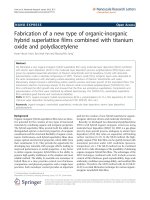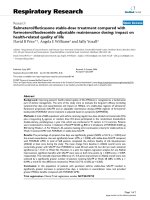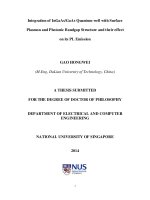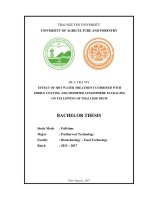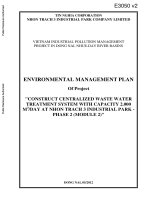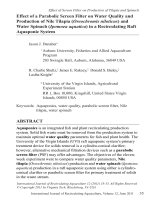Effect of hot water treatment combined with edible coating and modified atmosphere packaging on yellowing of thai lime fruit
Bạn đang xem bản rút gọn của tài liệu. Xem và tải ngay bản đầy đủ của tài liệu tại đây (6.69 MB, 86 trang )
THAI NGUYEN UNIVERSITY
UNIVERSITY OF AGRICULTURE AND FORESTRY
HUA TRA MY
EFFECT OF HOT WATER TREATMENT COMBINED WITH
EDIBLE COATING AND MODIFIED ATMOSPHERE PACKAGING
ON YELLOWING OF THAI LIME FRUIT
BACHELOR THESIS
Study Mode
: Full-time
Major
: Postharvest Technology
Faculty
: Biotechnology – Food Technology
Batch
: 2013 – 2017
Thai Nguyen, 2017
THAI NGUYEN UNIVERSITY
UNIVERSITY OF AGRICULTURE AND FORESTRY
HUA TRA MY
EFFECT OF HOT WATER TREATMENT COMBINED WITH
EDIBLE COATING AND MODIFIED ATMOSPHERE PACKAGING
ON YELLOWING OF THAI LIME FRUIT
BACHELOR THESIS
Study Mode : Full-time
Major
: Postharvest Technology
Faculty
: Biotechnology – Food Technology
Batch
: 2013 – 2017
Supervisor
: Assoc. Prof. Dr. Apiradee Uthairatanakiji
Ms. Trinh Thi Chung
Thai Nguyen, 2017
ABSTRACT
Thai Nguyen University of Agriculture and Forestry
Major
Postharvest Technology
Student name
Hua Tra My
Student ID
DTN1353140003
Thesis title
Supervisors
Effect of hot water treatment combined with edible coating and
modified atmosphere packaging on yellowing of Thai lime fruit
Assoc. Prof. Dr. Apiradee Uthairatanakij
Ms. Trinh Thi Chung
The influence of hot water treatment combined with edible coating on yellowing of
Thai lime fruit was studied. In experiment 1, mature green limes (C. aurantifolia Swingle)
treated with hot water dipping (HWD) at 50oC for 5 minutes and then dipped into solutions
containing 1.0%, 5.0% and 10.0% Sta-Fresh 8711 for 5 minutes. In experiment 2,
chitosan concentrations at 0.5%, 1.0%, 2.0% were used to coat surface of lime fruits for
1 minute after HWD. Untreated fruits were used as a control. Thereafter, the fruit were
stored at 25oC. The combination of HWD and 10.0% Sta-Fresh could retain the highest hue
angle value, likewise the L*, a*, b*, C* values were retarded, and coating reduced
percentage of weight loss during storage. HWD combined with 1.0% chitosan was the best
treatment which could reduce the percentage of weight loss and maintain the color quality in
the lime peel. Therefore, in order to evaluate the influence of combined treatments on quality
of lime fruit, the study continued a combination of the best treatment in experiments 1 and 2
with modified atmosphere packaging (PE bags and Active bags) stored at 13oC for 20 days.
The treatment combined with Sta-Fresh sealed in active bag induced a retarding chlorophyll
content in both chlorophyll a and b. Fruits treated in hot water dipping and Sta-Fresh has
brought positive effects on peel colour, content of titratable acid, respiration rate and pitting
of the lime peel. Combination of hot water treatment and Sta-Fresh was recommended to
effectively controlling chlorophyll degradation and the quality of Thai lime fruit during
storage.
Number of pages
Hot water treatment, Sta-Fresh 8711, chitosan, modified
atmosphere packaging, chlorophyll degradation
74 pages
Date of submission
26/06/2017
Key words
i
ACKNOWLEDGEMENT
I would like to express my appreciation and gratitude for the assistance of those
who contributed to the completion of this study. First of all, I would like to sincerely
express my thanks to my supervisor, Assoc. Prof. Dr. Apiradee Uthairatanakiji, who
gave me a great opportunity to do the internship at King Mongkut’s University of
Technology Thonburi, Thailand, whose understanding, guidance and support. I am
grateful to my co-advisor Ms. Trinh Thi Chung of Faculty of Biotechnology and Food
Technology, Thai Nguyen University of Agriculture and Forestry, Vietnam, for her
support, encourage and help. Thanks for being my great teacher.
Besides my advisor, I would like to thank my instructor, Ms. Chalida Cholmaitri
for your guidance, experience, thanks for helping me all the time when I was doing my
internship. And I am grateful to my special friend, Ms. Esther Yap Shiau Ping. Thanks
for your helping, suggestions and sharing your great experience, both academic and
non-academic.
My sincere thanks also goes to all staff members from physiological laboratory
and from department of Postharvest Technology Division, School of Bioresources and
Technology, King Mongkut’s University of Technology Thonburi, Thailand. I would
like to thank all sister and brother from Vietnam and all Vietnamese friends, for their
kindness, encourage, valuable advises and assistance during my stay in Thailand.
Likewise, word could not express my sincerest appreciation to all teachers of
Postharvest Technology and Faculty of Biotechnology and Food Technology, Thai
Nguyen University of Agriculture and Forestry, Vietnam, for their knowledge,
guidance, supported my education.
Last but not the least, I would like to thank my family: my parents and my elder
sister for supporting me spiritually throughout internship course and my life in general.
To all these people and others, thank you.
ii
TABLE OF CONTENTS
ABSTRACT ......................................................................................................... i
ACKNOWLEDGEMENT ................................................................................. ii
TABLE OF CONTENTS .................................................................................. iii
LIST OF FIGURES AND TABLES................................................................. iv
LIST OF ABBREVIATIONS ............................................................................ x
PART 1. INTRODUCTION .............................................................................. 1
1.1
Research rationale ....................................................................................... 1
1.2
Problem statement and justification............................................................. 2
1.3
Objectives ................................................................................................... 7
1.4
Expected benefit ......................................................................................... 8
PART 2. MATERIALS AND METHODS ........................................................ 9
2.1
Fruit supply and handling............................................................................ 9
2.2 Experimental design ................................................................................ 9
2.3 Analytical procedures ............................................................................ 11
PART 3. RESULT AND DISCUSSION .......................................................... 13
3.1
Experiment 1: Effect of hot water treatment combined with three Sta-Fresh
8711 concentration on yellowing of lime fruit .................................................... 13
3.2
Experiment 2: Effect of hot water treatment combined with various chitosan
concentration on de-greening of lime during storage .......................................... 20
3.3
Experiment 3: Effect of hot water treatment combined with edible coating
and modified atmosphere packaging on yellowing of lime fruit. ........................ 25
PART 4. CONCLUSION AND RECOMMENDATION ............................... 42
REFERENCES ................................................................................................. 44
APPENDICES .................................................................................................. 50
iii
LIST OF FIGURES AND TABLES
Figure 1. The chlorophyll degradation pathway of higher plants (Zhang et al., 2008) .... 3
Figure 2 Visual peel color changes in lime fruit when non-treated and treated with hot
water (HWT) at 50oC for 5 minutes and combined with various Sta-Fresh 8711
concentration under room temperature. ........................................................................ 13
Figure 3 Changes in hue angle value of peel treated with hot water at 50oC for 5
minutes, hot water combined with various Sta-Fresh concentration (1.0%, 5.0%, 10.0%)
and non-treated fruits (** = P<0.01, * = P<0.05, ns = P>0.05)..................................... 14
Figure 4 Changes in L* value of peel treated with hot water at 50oC for 5 minutes, hot
water combined with various Sta-Fresh concentration (1.0%, 5.0%, 10.0%) and nontreated fruits (* = P<0.05). ........................................................................................... 15
Figure 5 Changes in a* value of peel treated with hot water at 50oC for 5 minutes, hot
water combined with various Sta-Fresh concentration (1.0%, 5.0%, 10.0%) and nontreated fruits................................................................................................................. 16
Figure 6 Changes in b* value of peel treated with hot water at 50oC for 5 minutes, hot
water combined with various Sta-Fresh concentration (1.0%, 5.0%, 10.0%) and nontreated fruits (* = P<0.05). ........................................................................................... 16
Figure 7 Changes in C* value of peel treated with Hot water at 50oC for 5 minutes, hot
water combined with various Sta-Fresh concentration (1.0%, 5.0%, 10.0%) and nontreated fruits (* = P<0.05). ........................................................................................... 17
Figure 8 Changes in weight loss of lime fruit treated with hot water at 50oC for 5
minutes, hot water combined with various Sta-Fresh concentration (1.0%, 5.0%, 10.0%)
and non-treated fruits (** = P<0.01). ........................................................................... 18
Figure 9 Visual peel color changes in lime fruit when non-treated and treated with hot
water (HWT) at 50oC for 5 minutes and combined with various Chitosan concentration
under room temperature. .............................................................................................. 20
Figure 10 Changes in hue angle value of peel treated with hot water at 50oC for 5
minutes, hot water combined with various Chitosan concentration (0.5%, 1.0%, 2.0%)
and non-treated fruits. .................................................................................................. 21
iv
Figure 11 Changes in L* value of peel treated with hot water at 50oC for 5 minutes, hot
water combined with various Chitosan concentration (0.5%, 1.0%, 2.0%) and nontreated fruits................................................................................................................. 21
Figure 12 Changes in a* value of peel treated with hot water at 50oC for 5 minutes, hot
water combined with various Chitosan concentration (0.5%, 1.0%, 2.0%) and nontreated fruits................................................................................................................. 22
Figure 13 Changes in b* value of peel treated with hot water at 50oC for 5 minutes, hot
water combined with various Chitosan concentration (0.5%, 1.0%, 2.0%) and nontreated fruits................................................................................................................. 23
Figure 14 Changes in weight loss treated with hot water at 50oC for 5 minutes, hot water
combined with various Chitosan concentration (0.5%, 1.0%, 2.0%) and non-treated
fruits. ........................................................................................................................... 24
Figure 15 Visual peel color changes in lime fruits within 20 days of storage at 13oC ... 26
Figure 16 Changes in Hue angle value of peel treated with hot water combined with
edible coating and non-heat treated kept in PE and Active bags at 20 storage days (** =
P<0.01) ........................................................................................................................ 27
Figure 17 Changes in L* value of peel treated with hot water combined with edible
coating and non-heat treated kept in PE and Active bags at 20 storage days (** =
P<0.01, * = P<0.05). .................................................................................................... 28
Figure 19 Changes in a* value of peel treated with hot water combined with edible
coating and non-heat treated kept in PE and Active bags at 20 storage days (** =
P<0.01). ....................................................................................................................... 29
Figure 20 Changes in b* value of peel treated with hot water combined with edible
coating and non-heat treated kept in PE and Active bags at 20 storage days (** =
P<0.01, * = P<0.05). .................................................................................................... 29
Figure 21 Changes in C* value of peel treated with hot water combined with edible
coating and non-heat treated kept in PE and Active bags at 20 storage days (** =
P<0.01). ....................................................................................................................... 30
Figure 22 Changes in chlorophyll a content of peel treated with hot water combined
with edible coating and non-heat treated kept in PE and Active bags at 20 storage days
(** = P<0.01, * = P<0.05). .......................................................................................... 32
v
Figure 23 Changes in chlorophyll b content of peel treated with hot water combined
with edible coating and non-heat treated kept in PE and Active bags at 20 storage days
(** = P<0.01)............................................................................................................... 33
Figure 24 Changes in total chlorophyll content of peel treated with hot water combined
with edible coating and non-heat treated kept in PE and Active bags at 20 storage 20
days (** = P<0.01, * = P<0.05). .................................................................................. 34
Figure 25 Changes in respiration of lime fruit treated with hot water combined with
edible coating and non-heat treated kept in PE and Active bags at 20 storage days (** =
P<0.01, * = P<0.05). .................................................................................................... 35
Figure 26 Changes in titratable acidity of lime fruit treated with hot water combined
with edible coating and non-heat treated kept in PE and Active bags at 20 storage days.
.................................................................................................................................... 37
Figure 27 Pitting area in the peel of fruits treated with Sta-Fresh sealed in PE bags and
stored at 13oC during storage. ...................................................................................... 38
Figure 28 Changes in pitting area in the peel of lime fruit treated with hot water
combined with edible coating and non-heat treated kept in PE and Active bags at 20
storage days (** = P<0.01). ......................................................................................... 39
4.3.6.
Diseases severity ............................................................................................ 40
Figure 29 Visual of diseases severity in the peel of lime fruit within 20 days of storage
at 13oC. ....................................................................................................................... 40
Figure 30 Changes in diseases severity in the peel of lime fruit treated with hot water
combined with edible coating and non-heat treated kept in PE and Active bags at 20
storage days. ................................................................................................................ 40
Table 1 Effect of hot water treatment (HWT) at 50oC for 5 minutes combined with
various Sta-Fresh 8711 concentrations on Hue angle values of lime peel stored at room
temperature (25oC) for 6 days ...................................................................................... 50
Table 2 Effect of hot water treatment at 50oC for 5 minutes combined with various StaFresh 8711 concentrations on L* values of lime peel stored at room temperature (25oC)
for 6 days ..................................................................................................................... 51
vi
Table 3 Effect of hot water treatment at 50oC for 5 minutes combined with various StaFresh 8711 concentrations on a* values of lime peel stored at room temperature (25oC)
for 6 days ..................................................................................................................... 52
Table 4 Effect of hot water treatment at 50oC for 5 minutes combined with various StaFresh 8711 concentrations on b* values of lime peel stored at room temperature (25oC)
for 6 days ..................................................................................................................... 53
Table 5 Effect of hot water treatment at 50oC for 5 minutes combined with various StaFresh 8711 concentrations on C* values of lime peel stored at room temperature (25oC)
for 6 days ..................................................................................................................... 54
Table 6 Effect of hot water treatment at 50oC for 5 minutes combined with various StaFresh 8711 concentrations on percentage of weight loss of lime fruits stored at room
temperature (25oC) for 6 days ...................................................................................... 55
Table 7 Effect of hot water treatment (HWT) at 50oC for 5 minutes combined with
chitosan on hue angle value of lime peel stored at room temperature (25oC) for 6 days 56
Table 8 Effect of hot water treatment at 50oC for 5 minutes combined with chitosan L*
value of lime peel stored at room temperature (25oC) for 6 days .................................. 57
Table 9 Effect of hot water treatment at 50oC for 5 minutes combined with chitosan on
a* value of lime peel stored at room temperature (25oC) for 6 days ............................. 58
Table 10 Effect of hot water treatment at 50oC for 5 minutes combined with chitosan on
b* value of lime peel stored at room temperature (25oC) for 6 days ............................. 59
Table 11 Effect of hot water treatment at 50oC for 5 minutes combined with chitosan on
a* value of lime peel stored at room temperature (25oC) for 6 days ............................. 60
Table 12 Effect of hot water treatment at 50oC for 5 minutes combined with chitosan on
percentage of weight loss of lime fruits stored at room temperature (25oC) for 6 days . 61
Table 13 Effect of hot water treatment (HWT) at 50oC for 5 minutes combined with
edible coating and modified atmosphere packaging on total chlorophyll content of lime
fruits stored at 13oC for 20 days ................................................................................... 62
Table 14 Effect of hot water treatment at 50oC for 5 minutes combined with edible
coating and modified atmosphere packaging on total carotenoid content of lime fruits
stored at 13oC for 20 days ............................................................................................ 63
vii
Table 15 Effect of hot water treatment at 50oC for 5 minutes combined with edible
coating and modified atmosphere packaging on hue angle value of peel of lime fruits
stored at 13oC for 20 days ............................................................................................ 64
Table 16 Effect of hot water treatment at 50oC for 5 minutes combined with edible
coating and modified atmosphere packaging on L* value of peel of lime fruits stored at
13oC for 20 days .......................................................................................................... 65
Table 17 Effect of hot water treatment at 50oC for 5 minutes combined with edible
coating and modified atmosphere packaging on a* value of peel of lime fruits stored at
13oC for 20 days .......................................................................................................... 66
Table 18 Effect of hot water treatment at 50oC for 5 minutes combined with edible
coating and modified atmosphere packaging on b* value of peel of lime fruits stored at
13oC for 20 days .......................................................................................................... 67
Table 19 Effect of hot water treatment at 50oC for 5 minutes combined with edible
coating and modified atmosphere packaging on C* value of peel of lime fruits stored at
13oC for 20 days .......................................................................................................... 68
Table 20 Effect of hot water treatment at 50oC for 5 minutes combined with edible
coating and modified atmosphere packaging on respiration rate of lime fruits stored at
13oC for 20 days .......................................................................................................... 69
Table 21 Effect of hot water treatment at 50oC for 5 minutes combined with edible
coating and modified atmosphere packaging on titratable acidity of lime fruits stored at
13oC for 20 days .......................................................................................................... 70
Table 22 Effect of hot water treatment at 50oC for 5 minutes combined with edible
coating and modified atmosphere packaging on pitting area of lime fruits stored at 13oC
for 20 days ................................................................................................................... 71
Table 23 Effect of hot water treatment at 50oC for 5 minutes combined with edible
coating and modified atmosphere packaging on disease severity of lime fruits stored at
13oC for 20 days .......................................................................................................... 72
Table 24 Effect of hot water treatment at 50oC for 5 minutes combined with edible
coating and modified atmosphere packaging on chlorophyll a content of lime fruits
stored at 13oC for 20 days ............................................................................................ 73
viii
Table 25 Effect of hot water treatment at 50oC for 5 minutes combined with edible
coating and modified atmosphere packaging on chlorophyll b content of lime fruits
stored at 13oC for 20 days ............................................................................................ 74
ix
LIST OF ABBREVIATIONS
HWT
Hot Water Treatment
HWD
Hot Water Dipping
MAP
Modified atmosphere packaging
SF
Sta-Fresh
CHI
Chitosan
PE
Polyethylene
CI
Chilling injury
x
PART 1. INTRODUCTION
1.1
Research rationale
The center of origin of citrus species was in Southeast Asia where it is today
one of the most important fruit crops. From there citrus crops have been spread all
over the world since prehistoric times and the inter-country movement of each variety
along trade routes makes a fascinating story. The oldest known reference to citrus
appears before 800BC in Sanskrit literature and citrus fruit is now cultivated in
tropical, subtropical (Pranamornkith, 2009). Citrus is one of the most important fruit
crops in the world because of the scale of its production and the health benefits
brought by consumption of either refreshing drinks or fresh fruit. There are many
commercial species of citrus available such as orange (C. sinensis (L.) Osb.), mandarin
and tangerine (C. unshiu Marc. and C. reticulata Blanco), lemon (C. Limon) and lime
(C. aurantifolia Swingle, C. Latifolia), grapefruit (C. paradisi Macf.), pomelo
(pummelo) (C. grandis Osb.), kumquat (Fortunella spp.), Citron (C. medica), Hassaku
(C. Hassaku tanaka), Calamondin (C. madurensis loureiro) (Ladanyia et al., 2010).
Lime fruit belongs to the genus Citrus and family Rutaceae. The fruit is
classified as a hesperidium or berry of special structure. There are two kinds of acid
lime: low acid (sweet) lime (C. limettioides Tanaka) cultivars such as ‘Indian sweet
lime’ (Palestine lime) and acid (sour) lime with cultivars such as ‘Thai’ lime (C.
aurantifolia swingle), also known as Mexican or West Indian lime with small fruit size
(Ladanyia et al., 2010). Lime (C. aurantifolia Swingle) is a Citrus species, which is a
popular ingredient in Mexican, Vietnamese and Thai cuisine. Lime has small, round,
ovate or short-elliptical fruits; present a very thin rind; smooth surface; and a greenishyellow color at maturity. The flesh is juicy and highly acidic with a distinctive aroma
(Rivera-Cabrera et al., 2010). The fruit is used in nearly every home in the tropics,
mainly to flavor food, but also to prepare drinks and for a variety of medicinal
applications. The rich flavor and acidic taste make lime a favorite for hot and spicy
dishes, either fresh or in the form of pickles and sauces. It is refreshing qualities come
in the form of lime juice, lime tea and in use on other fruit such as papaya. According
1
to the US Department of Agriculture National Nutrient Database (2016), the lime
fruits are nutrient-dense foods that can be a good sources of vitamin C, carbohydrates,
including dietary fiber, and many vitamins and minerals. (Chaisawadi et al., 2005)
reported of the possibility of using medicinal herbs from Thai food ingredients as
natural antimicrobial agents. Furthermore, lime peels showed high sensitivity for all
studied microbial such as Bacillus cereus, Salmonella typhi, and Staphylococus
aureus. In Thailand, lime (C. aurantifolia Swingle), locally known as ‘Ma-nao’, has
been used for providing a sour taste and its unique fragrance to enhance overall flavor
and aroma in various Thai foods. It is also used in Thai traditional medicine
(Pranamornkith, 2009).
For countries with tropical climates, like Thailand, citrus production is found on
all types of soil and under a wide range of climatic condition (Sethpakdee, 1997). This
because lime is an economically significant horticulture crop and the harvesting season
is mainly in July to September (Pranamornkith et al., 2005). Some large commercial
orchards were found in lowland areas, especially in the central plain which is a major
citrus growing area. Trees can be harvested three or four times a year. Nevertheless, it
is difficult to protect trees from insect pests in the warm temperatures throughout the
year (Jungbluth, 2000). The following statistics of FAOSTAT (2013) reported that,
Thai lemons and limes production was 132.170 tons (rank 17th in the world) and the
yield is increasing every year. However, the quantity of limes available varies from
season to season and in the dry season (February to April) the price of limes can
increase by as much as five to ten times. In contrast, the price of limes is very low in
the wet season because there is a surplus of fruits in the market (Chaisawadi et al.,
2005; Uthairatanakij et al., 2006). Therefore, this study aims to look at the effect
different postharvest treatments on the quality of lime fruits to ensure continuous
supply of lime fruits in the market.
1.2
Problem statement and justification
All fruits, vegetables and root crops are living biological organisms, having a
respiratory system, similar to that of humans. They continue their living processes
after harvest (Gaetano Paltrinieri et al., 2002). The interaction of metabolic and
2
environmental factors are responsible for many postharvest deteriorations. Among the
main causes of wastage are the following: General senescence, water loss, diseases
and pests; physical damages (mechanical injury), injuries from temperature effects
(chilling injuries, CI), and other causes. Although the loss of green color in senescent
leaves and ripening fruits is a natural phenomenon but the price of lime fruit is directly
affected by chlorophyll degradation. Since limes are commercially marketed as green
fruit, they are harvested when the skin is still green. Full with highly aromatic
compounds, lime fruit is important in some countries where it is processed to yield
lime oil and lime juice. Most of the customer in many countries prefer green lime to
yellow lime (Thompson, 2003). In addition, the quality of lime fruit deteriorates
quickly after harvest (Kaewsuksaeng et al., 2015) Therefore the maintenance of green
color in the peel of lime fruit is necessary.
Figure 1. The chlorophyll degradation pathway of higher plants (Zhang et al., 2008)
Occurrence of a yellow color in plant leaves denotes chlorophyll breakdown
that is a visible symptom of leaf senescence and is often also observable during
postharvest storage of fruit and vegetables under ambient temperature (Srilaong et al.,
2011).
3
Chlorophyll degradation is mediated through several processes such as action of
enzyme chlorophyllase, enzymatic oxidation and photodegradation. The process of
chlorophyll degradation which occurs during postharvest storage of horticultural crops
has been suggested to portray the following putative pathway. The major steps of the
chlorophyll catabolic pathway had been elucidated during the last two decades
(Hörtensteiner, Stefan, 2006; Hörtensteiner, S et al., 2004). The pathway starts with
the removal of the phytol moiety from the chlorophyll a molecule by chlorophyllase,
producing the first green breakdown product, chlorophyllide a.
Then, after the
removal of the central Mg2+ form chlorophyllide by Mg-dechelatase, the porphyrin
macrocycle of pheophorbide a is oxygenolytically cleaved by the joint action of
pheophorbide a oxygenase (PaO) and red chlorophyll catabolite reductase. The
product, a primary fluorescent catabolite, is further con-verted to the final nonfluorescent chlorophyll catabolites. The pathway was designated the PaO pathway due
to the critical function of PaO enzyme. Based on the fact that all the non-fluorescent
chlorophyll catabolites were identified as the derivatives of chlorophyll a, it was
proposed that the conversion of chlorophyll b to chlorophyll a is required for the
degradation of chlorophyll b via PaO pathway (Hörtensteiner, Stefan, 2006).
chlorophyll b reductases were suggested to be the enzymes responsible for the
conversion (Zhang et al., 2008). Therefore, delaying the chlorophyll degrading
enzymes could be a useful method to controlling the chlorophyll breakdown in plant.
The measures to control chlorophyll breakdown to reach or maintain the required color
of fruits in the postharvest handling chain are different. Since the present measures
may have different effects on chlorophyll breakdown in various fruits, the handling of
other fruits needs suitable selection and application (Zhang et al., 2008).
Effect of hot water treatment to postharvest quality of fruit and vegetable were
evaluated. There are three methods used such as hot water, vapor heat and hot air. Hot
water dips to control decay are often applied for a few minutes whereby the
temperature are used is higher than those for hot air, while, vapor heat only transfers
heat to the surface of the commodity (Lurie, 1998). However, hot air produces heat
slower than hot water or vapor heat, although forced hot air will heat produce faster
than a regular heating chamber.
4
Recently, there has been more interest on using hot water dip (HWD) since it is
easily applied, cheaper and more efficient as heat transfer medium compared to hot air
(Benitez et al., 2004). Hot water treatments could improve the resistance of cherry
tomato fruit to CI and Ultrastructural damage (Jing et al., 2009). Likewise, controlling
the Thielaviopsis Black rot of pineapple (Wijeratnam et al., 2005), reducing pathogen
development in citrus fruit (Lurie et al., 2004) were investigated. In addition, hot water
treatment by immersion of the citrus fruit at 52°C for one minute slowed the rate of rot
development by approximately 15% in litchi fruit (Olesen et al., 2004), immersion of
Broccoli in 50oC for two minutes to extended the shelf life of fresh Broccoli (Forney,
1995)and also improve the storage quality of sweet pepper (Fallik et al., 1999).
Alongside, different temperatures could reduce enzymes active and some heat
treatment could delay ripening as reported by (Khademi et al., 2013) on persimmon
whereby hot water treatment reduced the fresh browning. The study of (Tian, M. et al.,
1996) indicated treatment at 47oC for 7.5 min consistently reduced yellowing for up to
5 days. In addition, heat treatment on commodities also suppressed the activities of
chlorophyll oxidase in broccoli treated at 50 °C for 2 hours (Yamauchi et al., 2002).
Specifically in lime, (Kaewsuksaeng et al., 2015) reported that hot water treatment at
50oC for 5 minutes could be an useful method to delay chlorophyll degradation and to
maintain postharvest quality in mature green lime in storage.
Application of edible coating and films have been shown to improve food
quality (Elizaneth A., et al., 2002). Edible coatings are substances applied to the
exterior of food so that the final product is fit for consumption (Baldwin et al., 2011).
According to Attila E. Pavlath and William Orts (2009) edible films and coatings, such
as wax on various fruits, have been used for centuries to prevent loss of moisture and
to create a shiny fruit surface for aesthetic purposes. These practices were accepted
long before their associated chemistries were understood, and are still carried out in
the present day. The term, edible film, has been related to food applications only in the
past 50 years. The edible based on feature natural waxy coating called a cuticle of
plant (Baldwin et al., 2011). It could retard respiration, ethylene rate, water loss,
reduce weight loss, firm loss, ethanol fermentation, transpiration, control interval gas
composition, de-color.
5
For example, application of chitosan coating on enzymatic browning and decay
during postharvest storage of litchi (Litchi chinensis Sonn.) fruit (Quantick et al.,
1997) and possible control of postharvest diseases of tomato fruit (Tian, S. et al.,
2007) were demonstrated. Edible chitosan coating effectively prolongs the quality
attributes and extends the shelf life of sliced mango fruit (Chien et al., 2007), peels of
litchi fruit (Jiang et al., 2004) and red kiwifruit (Kaya et al., 2016). Furthermore, the
combination of hot water and chitosan treatments is a valid strategy to improve the
existing ones that were already used in controlling postharvest decay of sweet cherries
(Chailoo et al., 2011). In another study of combined effects of postharvest heat
treatment and chitosan coating on quality of fresh-cut mangoes (Magifera indica L.)
indicated that both hot water dipping at 50oC for 30 minutes and chitosan coating,
either alone or combined, did not a ect the taste and the flavor of mangoes slices but
maintained firmness and color for 9 days at 6oC. The chitosan coating was used as
antimicrobial proprieties (Djioua et al., 2010).
According to the information of Jirakorn Company (www.jirakorn.com) which
is the producer of Sta-Fresh 8711. Sta-Fresh product is a vegetable oil based coating as
well as chitosan which is an edible coating. It is ready to use the product formulated
from food-grade ingredients that are approved by Title 21 of the code Federal
Regulation by the U.S. Food and Drug Administration (FDA). Effect of Sta-Fresh
coating on storage life of mango cv. Namdokmai were also evaluated. The fruits were
last perceived to be marketable after 25 days of storage. Uncoated fruits kept for 20
days in storage (Kaewchana et al., 2003). Additionally, lime fruit coated with StaFresh no.360 mix with GA3 at 0, 20, 100 and 500 ppm, stored at 0.03, 1 and 5 percent
CO2 could prolong their storage life up to 60 days (Kanlayanarat et al., 2003).
Furthermore, edible coatings are environmental friendly technology that are applied on
many products to control cuticle transpiration, gas exchange or oxidation processes.
Edible coatings can provide an additional protective coating and can also give the
same effect as modified atmosphere storage in modifying internal gas composition
(Dhall, 2013).
Consequently, a combination of hot water and edible coating
treatments could be an effective method to retain postharvest quality of lime fruits
during storage.
6
Packaging is increasingly important as part of the communicator role to reach
the consumer through printing and package appearance. In addition, new packaging
technologies are creating advancements in barrier polymers, improved sealant
polymers, and abuse properties. The composition of the storage atmosphere can
significantly affected to the storage life of horticultural crops. Modified atmosphere
packing (MAP), a technique used to prolong the shelf life of fresh or minimally
processed foods, refers to the development of an MA around the product through the
use of permeable polymeric films. MAP is used with various types of products, where
the mixture of gases in the package depends on the type of product; packaging
materials and storage temperature. It can be broadly defined as any process that
significantly changes the environment around the product from the normal
composition of air in a package (Yahia, 2009). MAP can become an important
supplement to other postharvest technologies for the quality maintenance of fruit and
vegetables in both the developed and developing countries.
Application of MAP have been done on the quality of fruits and vegetables
such as the combination of wax and packaging to prolong the post-harvest preservation
of acid limes (Caron et al., 2015); Reduction of postharvest rind disorders in citrus
fruit by modified atmosphere packaging (Porat et al., 2004); the effects of various
postharvest treatments on quality changes in main- and late-season New Zealand lime
fruit (Pranamornkith et al., 2005) and the study of Uthairatannakiji (2006) reported
that controlled atmosphere storage retained physiological changes of lime fruit better
than control treatment (Uthairatanakij et al., 2006).
Therefore, this study aims to look at the effect different postharvest treatments
on the quality of lime fruits to ensure continuous supply of lime fruits in the market.
1.3
Objectives
• To study the effect of hot water treatment combined with various Sta-Fresh
8711 concentration on yellowing of lime fruit.
• To study the effect of hot water treatment combined with chitosan on yellowing
of lime fruit.
7
• To determine the effect of hot water treatment combined with edible coating
and modified atmosphere packaging (MAP) on storage life and quality of lime
fruit.
1.4
Expected benefit
• To extend the knowledge regarding effect of hot water treatment combined with
Sta-Fresh 8711 coating on yellowing of lime fruit during storage.
• To improve the beneficial effects of hot water treatment combined with
chitosan coating on de-greening of lime fruit.
• To discern the effect of hot water treatment combined with edible coating and
modified atmosphere packaging on retardation of chlorophyll breakdown and
other physiological processes through which this study will widen an
understanding how the treatments result in control of chlorophyll degradation in
lime fruit.
8
PART 2. MATERIALS AND METHODS
2.1
Fruit supply and handling
Mature green Thai limes (C. aurantifolia Swingle) fruit were purchased from
Ratchaburi Province, Thailand. Fruit were transported to the laboratory at King
Mongkut’s University of Technology Thonburi. Fruit were classified for
uniformity in maturity, size, shape, peel color, and blemish.
2.2
Experimental design
2.2.1 Experiment 1: Effect of hot water treatment and concentration of StaFresh 8711 on the yellowing of lime
Lime fruits were bought and delivered to the laboratory and selected as
described above. Mature green lime fruits were dipped in hot water at 50oC for 5
minutes, after hot water treatment, the samples were promptly immersed in ice
water at 10oC for 10 minutes to cool down and dried at ambient room temperature
(25±2oC). Fruits were individually dipped for 5 minutes into solutions containing
1.0%, 5.0% and 10.0% Sta-Fresh 8711 and then air-dried at room temperature.
Untreated fruits were used as a control. Thereafter, the fruit were stored at 25oC.
Samples from each treatment was evaluated the peel color and weight loss daily
until lime peel yellowing occurred.
The treatments were as following:
1)
Non treated fruit (control)
2)
Hot water treatment at 50oC for 5 minutes (HWT)
3)
HWT + coated with Sta-Fresh 8711 at 1.0%
4)
HWT + coated with Sta-Fresh 8711 at 5.0%
5)
HWT + coated with Sta-Fresh 8711 at 10.0%
9
2.2.2 Experiment 2: Effect of hot water treatment and chitosan coating on
the yellowing of lime fruit
Fruits described in 2.1 were used in this experiment. Fruit were subjected
to hot water at 50oC for 5 minutes, after hot water treatment, the samples were
immediately immersed in ice water 10oC to cool down for 10 minutes. Original
chitosan solution 2% were diluted by distilled water to series of 0.5%, 1.0%,
2.0% concentrations. Thereafter, samples were dipped for 1 minute into various
chitosan concentration and then air-dried at room temperature. Untreated fruits
were used as the control. After complete dried, the fruits were stored at 25oC.
Samples from each treatment were measured the peel color and weight loss every
day until de-greening in the peel of lime.
The treatments were as following:
1)
Non-treated fruits
2)
Hot water treatment at 50oC for 5 minutes (HWT)
3)
HWT + coated with chitosan at 0.5%
4)
HWT + coated with chitosan at 1.0%
5)
HWT + coated with chitosan at 2.0%
2.2.3 Experiment 3: Effect of hot water treatment combined with chitosan
and Sta-Fresh 8711 coating and modified atmosphere packaging (MAP) on
storage life and quality of lime fruit
In this experiment, the best treatment to retain the best characteristics of
lime fruit from experiment 1 and 2 had been chosen. Packaging used in this
experiment were polyethylene film bags (0.03 mm in thickness) with perforated
(6 holes) and active bags with the top folded over. The experiment design was a
complete randomized design with three replicates. Each replicate contained 4 fruits
(approximately 180 gram/bag). All treatments were kept at 13°C in dark. Samples
were withdrawn for analysis at four days interval and storage period being 20 days.
The treatments were as follows:
1)
Non-heat treated fruits
2)
Non-heat treated fruits + Polyethylene (PE) bags
10
3)
Non-heat treated fruits + Active bags
4)
Hot water treatment at 50oC for 5 minutes (HWT) + Sta-Fresh + PE bags
5)
HWT + Sta-Fresh + Active bags
6)
HWT + chitosan + PE bags
7)
HWT + chitosan + Active bags
2.3
Analytical procedures
2.3.1 Determination peel of color
A Minolta chromameter (model CR-200, Minolta Camera Co., Ltd, Osaka,
Japan) was used for measuring fruit peel color during storage. Peel colour of fruit
were measured Hunter L*, a*, b*, C* values. Hue angle of 0, 90, 180 and 270
degrees showed corresponding red-purple, yellow, bluish-green and blue color.
2.3.2 Weight loss
Every lime fruit in the same selected packages for each treatment was
determined by weighing at the initial weight and during storage and then
calculating weight loss by weight differences. Results were expressed as the
percentage of weight loss (%).
Weight loss (%) = (The initial weight of fruit – The final weight of fruit) ×100
The initial weight of fruit
2.3.3 Determination of respiration rate
Two fruits were placed in a 240 ml air-tight plastic container, incubated at room
temperature for 1 hour. A 1 ml sample of headspace gas was taken by hypodermic
syringe and injected into the LI-7000 CO2/H2O Analyzer (LI-COR Biosciences) with
nitrogen used as a carrier gas.
2.3.4 Determine of Chlorophyll content
Chlorophyll content was determined according to Moran (1982). A sample
of 0.2 g of lime fruit peel was homogenized in 10 ml of N, N-dimethylformamide
and kept in the dark under 4oC for 24 hours to elute the chlorophyll pigments
completely. Thereafter, the mixture was filtered through Whatman No. 1 filter
paper. The extracted filtrate was assayed for chlorophyll a, chlorophyll b, and
11
total chlorophyll content with a spectrophotometer (UV-1800, SHIMADZU,
Japan) at 663 and 647 nm for chlorophyll a and chlorophyll b respectively:
Chlorophyll content was calculated using Arnon (1949) equations:
Chlorophyll a = (12.70A663 - 2.79A647) × dilution factor/1000
Chlorophyll b = (20.70A647 - 4.62A663) × dilution factor/1000
Total chlorophyll = (20.20A663 + 8.02A647) × dilution factor/1000
Where, A663 = OD value at 663 nm
A647 = OD value at 647 nm
The chlorophyll content was expressed and reported as mg/100 g FW.
2.3.5 Total acids (TA)
The titratable acidity (TA) of fruit juice was determined by titrating 1 ml of
fruit juice diluted 10 times with distilled water against 0.1 N NaOH, using 1-2
drops of 1% (v/v) phenolphthalein as an indicator to light pink color as end-point.
Titratable acidity was calculated as below formula and expressed as the percentage of
the citric acid content (meq. Citric acid = 0.064) (Opio et al., 2015).
Formula used
% Titratable acidity = (ml NaOH) × (N NaOH) × (meq. Wt. citric acid) ×100
Volume of sample (ml)
2.3.6 Pitting area
Pitting area on fruit surface was evaluated by a scale of visual symptom: 0 = no
pitting; 1 = less than 10%, 2 = 10 - 20%; 3 = 30 - 40% and 4 = more than 50% of fruit
affected (Kluge et al., 2003).
2.3.7 Diseases severity
Diseases severity was evaluated by means of a subjective scale of disease
affecting area: 0 = no disease; 1 = 0.1 - 5.0%; 2 = 5.1 – 10.0%; 3 = 10.1 – 15.0%; 4 =
15.1 – 20.0%; 5 > 20%.
12
PART 3. RESULT AND DISCUSSION
3.1
Experiment 1: Effect of hot water treatment combined with three Sta-
Fresh 8711 concentration on yellowing of lime fruit
Lime (C. aurantifolia Swingle) is widely consumed at the green stage.
Unfortunately, de-greening due to the chlorophyll degradation happen during
postharvest handling. As with many products, the price of the fruit is strongly
dependent on its availability and quality characteristics (Pranamornkith et al., 2005).
Moreover, the external appearance of lime fruit is used by consumers as an indication
of quality (Miller, 1946). The influence of heat treatment and edible film on the quality
of fruits were demonstrated. In this experiment, effect of postharvest hot water
treatment combined with various Sta-Fresh 8711 concentration on yellowing of lime
fruit under room temperature within 7 days of storage were evaluated.
3.1.1 Effect of hot water treatment combined with various Sta-Fresh 8711
concentration on color change in lime fruit peel
Non-treated
HWT 50oC, 5 min
HWT 50oC, 5 min,
Sta-Fresh 1.0%
HWT 50oC, 5 min,
Sta-Fresh 5.0%
HWT 50oC, 5 min,
Sta-Fresh 10.0%
Day 0
Day 3
Day 6
Figure 2 Visual peel color changes in lime fruit when non-treated and treated with hot
water (HWT) at 50oC for 5 minutes and combined with various Sta-Fresh 8711
concentration under room temperature.
13


